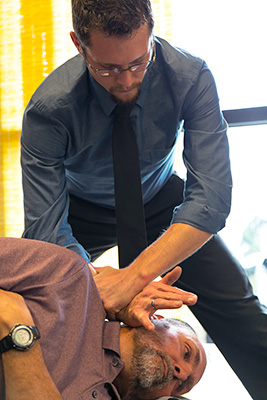 The term vertigo is often misunderstood. Some use it to refer to dizziness, lightheadedness, or feeling faint. Others think it is the fear of heights due to the popularity of an older movie. So, let’s take a closer look at what vertigo is, and then we will discuss how it can be alleviated naturally.
The term vertigo is often misunderstood. Some use it to refer to dizziness, lightheadedness, or feeling faint. Others think it is the fear of heights due to the popularity of an older movie. So, let’s take a closer look at what vertigo is, and then we will discuss how it can be alleviated naturally.
Vertigo is a particular type of dizziness that is experienced as the false sensation of movement. When you have an episode of vertigo, you feel as if you or your environment are spinning about. It is similar to when we were children and spun around and around, and then suddenly stopped, but it felt as if the things around us were still moving. It is important to realize that vertigo is not a condition that one is diagnosed with, but rather a description of a feeling or sensation. Vertigo is often accompanied by:
These symptoms can be quite severe and cause you to have to lie down until they pass. Vertigo can cause you to miss out on life’s important events. While vertigo is rarely life threatening, in certain situations, it can be quite dangerous, like when driving a car, flying, climbing a ladder, or operating heavy machinery.
Vertigo is mostly the result of a disorder of the parts of the ear and brain involved in controlling balance:
It is vital to understand how this all works, in order to find out how best to help it. The inner ear contains such structures as semicircular canals that help the brain know where the body is located in its environment and how it is moving. This information is delivered via the vestibulocochlear nerve or the 8th cranial nerve – the one responsible for hearing. This important information is then managed in the brainstem to adjust posture accordingly. The cerebellum also plays a part in coordinating movement to keep balance. If any of these structures is not functioning at its optimum, vertigo can be the end result. You may also notice tinnitus (ringing in the ears) and hearing loss.
Other things that may lead to dizziness or vertigo are:
The following conditions have vertigo as one of their main symptoms:
A study was performed in order to see what role head and neck trauma played in the onset of vertigo and to discover whether upper cervical chiropractic care could improve vertigo at all. In this study, 60 people were observed who had all been diagnosed with chronic vertigo. Each of these patients was cared for over an 8-year period. Out of the 60 patients, 56 recalled specific trauma before the onset of vertigo. This included automobile accidents, sporting accidents (skiing, biking, horseback riding), or falls on sidewalks or down stairs.
By means of specific imaging, it was found that all 60 patients had an upper cervical misalignment. Each of them began receiving care from an upper cervical chiropractor tailored to their specific needs. The results were amazing! All 60 saw improvement in their symptoms within 1 to 6 months. Out of the patients in the study, 48 saw their vertigo go away entirely while the other 12 reported major improvements in the severity of their vertigo.
This clearly shows that vertigo can be brought about due to trauma to the head or neck. It also proves that by correcting the misalignment in the neck, vertigo can improve or go away. So, how is this done?
When visiting our Balanced Living office here in Vancouver, Washington, we will begin by giving you a thorough examination. We use imaging and technological advances along with precise, scientific measurements to help determine the exact location of your misalignment. Because this is different for every patient, we tailor each visit to fit you specifically. The supine leg check is used to find out if your legs are both the same length. This is the basic standard to find out if you have an upper cervical misalignment.
We use what is referred to as NUCCA. We begin our adjustment by having you lie on an adjusting table on your side and position your head in a certain way to optimize the care. The doctor then uses a number of light and subtle corrections to help the bones of the neck move back into their proper position. The table does not move nor do we push or twist when doing the correction to the neck bones. You will basically feel light pressure and the adjustment only takes a few minutes. It takes very little pressure to get the neck bones to realign and relieve the pressure within.
Each spinal correction and recovery is individual to each person and is, therefore, monitored closely by follow up visits. However, adjustments are only given when absolutely necessary. Healing takes time and may require a few additional adjustments depending on the nature of the misalignment and how long it has been left uncared for.
Once this is completed, the body can begin communicating properly with the brain once again. This means the improper signals being sent to the brain about the body’s location will return to normal. Vertigo may improve or go away entirely.
To schedule a consultation with Dr. Joe Perin, call our Vancouver office at 360-569-1740. You can also click the button below.
If you are outside of the local area, you can find an Upper Cervical Doctor near you at www.uppercervicalawareness.com.



